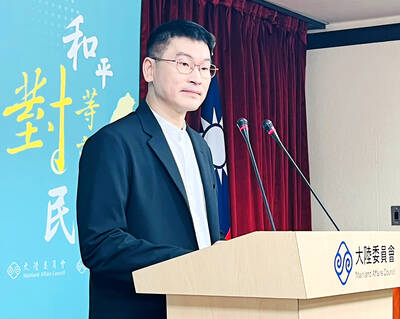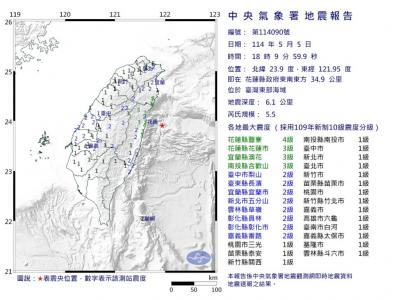Half a century ago, six men with no sailing experience climbed aboard an aging Chinese junk in Taiwan and survived a typhoon that nearly wrecked the little ship. But after sailing nearly 11,500km across the Pacific, they were greeted by cheering crowds as they sailed under the Golden Gate Bridge.
Now that turn-of-the-century junk, which experts say may be the last salvageable vessel of its type, could be destroyed if it does not find a permanent home by the end of the month.
With it would go a piece of US and Chinese history — the boat’s name, the Free China, evokes Cold War rhetoric. But the ship also holds the unwritten knowledge of traditional Chinese boat building, said Hans Van Tilburg, a historian with the US National Oceanic and Atmospheric Administration.

PHOTO: AP
“It’s a rare document, a rare record of hundreds, maybe thousands of years of seafaring tradition,” said Van Tilburg, who has written about the Free China in his book, Chinese Junks on the Pacific. “This was never recorded. It was always an art, a skill passed down in families.”
The junk is sitting in a Sacramento River Delta boatyard in California — abandoned by the last of a series of volunteer caretakers after he fell behind on storage payments. And the boat yard owner has given notice that it must be removed.
The hull has integrity; the curved wooden planks bent over fire by craftsmen on the Fujian coast are still true. But the painted eels and phoenixes that brought luck are long gone, as are the mast and the battened sails. A 4m section of hull was hacked off the stern so the boat would take less room in storage.
But to Dione Chen, the aging hulk evokes the stories her father, Reno Chia-lin Chen, told about his 112-day trip from Taiwan in 1955.
He was one of five middle-class professionals who fled the Chinese revolution and wound up as commercial fishermen in Taiwan. The dangerous work held no future, so one of them, Paul Chow, seized upon a newspaper item about a yacht race from the US to Sweden; they sent in an application to enter the contest and somehow were accepted.
“There was never going to be any other way to come to America,” Dione Chen said. “There was never going to be any sponsor, any money, any job, any relative to help.”
The young men had no boat, so they sold what they had —- even bikes and typewriters — to raise money.
The then governor of Taiwan offered to purchase an aging junk if they would name it the Free China to advertise Taiwan’s dispute with the People’s Republic of China.
When they applied at the US consulate for US visas, Vice Consul Calvin Mehlert — also in his 20s — not only granted them the papers but asked for a place on board for an adventure of a lifetime, even if it wasn’t well planned.
“I thought ‘This isn’t a big deal, the winds blow in that direction,”’ said Mehlert, now 80. “I knew I’d never get another chance like this.”
After a failed launch attempt damaged the boat, delaying their departure from Keelung harbor, a typhoon off Okinawa destroyed the junk’s rigging and forced weeks of repair in Yokohama, Japan.
They had hoped to sail through the Panama Canal to join the trans-Atlantic race in July, but the delays made that impossible.
In the end, the junk never left San Francisco.
And yet, the trip across the Pacific went smoothly. They even kept two chickens; photos and movies shot by Mehlert show the crew feeding the birds — and turning one into dinner on Paul Chow’s birthday.
Arriving in San Francisco, they were feted with invitations, a TV appearance and a historic marker.
Chow eventually became a physics professor at California State University, Northridge, and Chen an engineer. Mehlert returned to Taiwan and served as an interpreter during former president Richard Nixon’s 1972 visit to China.
The junk did not fare as well, Dione Chen said.
“Many people were passionate about it, fell in love with it, but it never had a permanent caretaker,” she said.
After Reno Chen died in September last year, Dione Chen took her children to see the junk and was moved by the sight.
“It struck me that this is a unique vessel, that tells a bigger story — of immigration, of the Chinese community, of my own family,” she said. “I was on the hook. I started doing everything I could to save it.”
She reached out to the San Francisco Maritime National Historical Park, where curator John Muir recognized the 20m vessel’s rarity.
“It’s a basically extinct vessel type,” Muir said. “It’s very likely one of the last remaining original vessels of this type.”
However, the maritime park run by the National Park Service cannot afford to take in the vessel, Muir said.
On the Net: Maritime National Historical Park: http://www.nps.gov/safr/ “Free China:” http://www.chinesejunkpreservation.com

An essay competition jointly organized by a local writing society and a publisher affiliated with the Chinese Communist Party (CCP) might have contravened the Act Governing Relations Between the People of the Taiwan Area and the Mainland Area (臺灣地區與大陸地區人民關係條例), the Mainland Affairs Council (MAC) said on Thursday. “In this case, the partner organization is clearly an agency under the CCP’s Fujian Provincial Committee,” MAC Deputy Minister and spokesperson Liang Wen-chieh (梁文傑) said at a news briefing in Taipei. “It also involves bringing Taiwanese students to China with all-expenses-paid arrangements to attend award ceremonies and camps,” Liang said. Those two “characteristics” are typically sufficient

A magnitude 5.9 earthquake that struck about 33km off the coast of Hualien City was the "main shock" in a series of quakes in the area, with aftershocks expected over the next three days, the Central Weather Administration (CWA) said yesterday. Prior to the magnitude 5.9 quake shaking most of Taiwan at 6:53pm yesterday, six other earthquakes stronger than a magnitude of 4, starting with a magnitude 5.5 quake at 6:09pm, occurred in the area. CWA Seismological Center Director Wu Chien-fu (吳健富) confirmed that the quakes were all part of the same series and that the magnitude 5.5 temblor was

The brilliant blue waters, thick foliage and bucolic atmosphere on this seemingly idyllic archipelago deep in the Pacific Ocean belie the key role it now plays in a titanic geopolitical struggle. Palau is again on the front line as China, and the US and its allies prepare their forces in an intensifying contest for control over the Asia-Pacific region. The democratic nation of just 17,000 people hosts US-controlled airstrips and soon-to-be-completed radar installations that the US military describes as “critical” to monitoring vast swathes of water and airspace. It is also a key piece of the second island chain, a string of

The Central Weather Administration has issued a heat alert for southeastern Taiwan, warning of temperatures as high as 36°C today, while alerting some coastal areas of strong winds later in the day. Kaohsiung’s Neimen District (內門) and Pingtung County’s Neipu Township (內埔) are under an orange heat alert, which warns of temperatures as high as 36°C for three consecutive days, the CWA said, citing southwest winds. The heat would also extend to Tainan’s Nansi (楠西) and Yujing (玉井) districts, as well as Pingtung’s Gaoshu (高樹), Yanpu (鹽埔) and Majia (瑪家) townships, it said, forecasting highs of up to 36°C in those areas